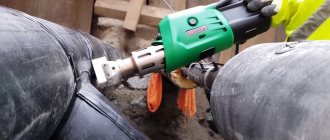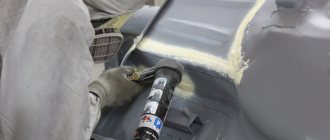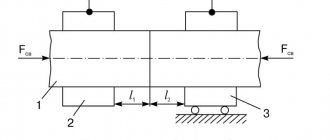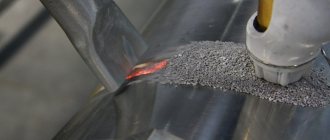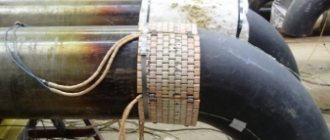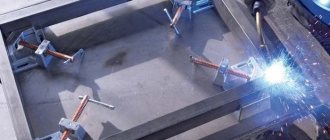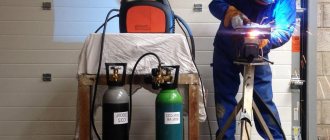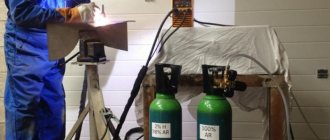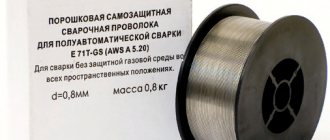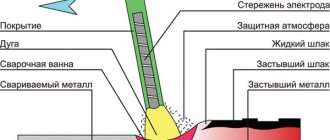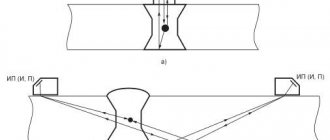Home / Welding technique
Back
Reading time: 2 min
0
408
One of the criteria by which reverse step welds are divided is their duration. This nuance affects the way the seam is formed.
Depending on the duration, they are divided into three groups. Short, medium and long welded joints.
- Types of seams by duration
- Voltage and distortion
- Reverse-stage cooking is divided into different types
Reverse-stage welding method
Content:
Reverse-stage welding is a special type of welding. When using it, the entire seam is divided into sections, and then each of them is welded alternately in the direction opposite to the increase in its length. The end of a particular stage coincides with the beginning of the previous one. The reverse-stage welding method involves preliminary dividing the entire length of the welded seam into equal sections. Their size depends on the size of the seam.
Pereosnastka.ru
Wood and metal processing
A weld is a section of a welded joint formed as a result of crystallization of molten metal. A weld is a part of a welded joint that differs in structure from the structure of the base metal.
Based on the type of connection and cross-sectional shape, welds are divided into butt and corner welds. Butt welds are used to make butt and, much less frequently, corner and T-joints. Fillet welds are used in corner, T and lap joints.
A butt weld is characterized by the width of the seam (e) and the depth of penetration (ft). The characteristics of a fillet weld are the width of the seam (e), the thickness of the seam (a) and the leg of the seam (K).
Depth of penetration of a butt weld (ft) is the greatest depth of fusion of the base metal in the cross section of the weld.
Fillet weld thickness (a) is the greatest distance from the surface of the fillet weld to the point of maximum penetration of the base metal.
Fillet weld leg (K) is the shortest distance from the surface of one of the parts being welded to the boundary of the fillet weld on the surface of the second part being welded. With a symmetrical fillet weld, any of the equal legs is taken as the design leg; with an asymmetrical weld, the smaller one is taken.
Weld convexity (g)—The convexity of the weld is determined by the distance between the plane passing through the visible boundary lines of the weld and the base metal and the surface of the weld, measured at the point of greatest convexity.
Rice. 1. Butt and fillet welds: e - weld width; h—penetration depth; g - convexity (reinforcement) of the seam; a is the thickness of the seam; c - seam leg
Types of seams
Weld seams, depending on their length, are divided into short, medium and large. The maximum length of the first is 300 mm. The average ones range from this value to 1000 mm. And the long ones, accordingly, have a length of over 1000 mm. Belonging to each type determines the welding method.
Short ones are welded in the same direction, moving the electrode continuously. The average ones are divided into a number of identical steps. Welding is then done in one of two ways: from the middle to the edges or in one direction.
The length of the step is chosen in such a way that 2-4 electrodes are consumed when welding it. The reverse-step method of welding long seams is carried out from the middle of the seam to its edges. The second option is random welding.
Welding work: A practical guide for electric and gas welders (24 pages)
Rice. 66. Methods for making a seam: a – welding seams “on the pass”; b – welding of medium-length seams; c – welding of seams using a reverse-step method; d, e – welding long seams
Short seams along the length are usually welded “for passage” (Fig. 66, a). Medium-length seams are welded from the middle to the edges (Fig. 66, b) or in a reverse-step manner (Fig. 66, c). Long seams of single-pass butt joints and the first pass of multi-pass welds are welded from the middle to the ends in a reverse-step manner (Fig. 66, d), and in joints with fillet welds also from the middle to the ends in a reverse-step manner (Fig. 66, e).
Reverse-stage welding is the most effective method of reducing residual stresses and deformations.
The previous seam cools to a temperature of 200-300 °C. During cooling, simultaneously with a decrease in the width of the seam, the initially expanded gap also decreases, which is why residual deformations become minimal.
When welding butt or fillet welds of large cross-section, the seam is made in several layers (Fig. 67). In this case, each layer of the middle and upper part of the seam can be performed either in one pass (Fig. 67, a) or in two or more passes (Fig. 67, b).
From the point of view of reducing residual deformations, welding in one pass is preferable. If the seam width reaches 14-16 mm, then a multi-pass seam welding method is more often used.
Advantages of the method
It is important to understand for what purposes the reverse step welding scheme is used. Reverse welding is an effective method of minimizing the deformations and stresses that occur during operation. In addition, this method helps to avoid warping of the welded parts.
Stress inside a part appears due to unequal heating and lowering of the temperature of its various parts when they contract and expand. Reducing the size of the weld pool as a result of its shrinkage can lead to deformation of parts of metal products bordering the seam. This happens because when it cools, it narrows, which leads to stretching of the nearest layers of metal and the appearance of distortions in them.
If the work is carried out correctly, the stresses inside, although present, do not cause severe deformations of the welded products. This method reduces internal stress. When adjacent small sections of the seam are applied, the deformations in them have opposite directions.
Return wire
It is necessary to understand such subtleties as the return wire, and what is acceptable to use as it when welding. The return wire during welding is a wire that provides connection to current sources. It is used as:
- wires - rigid and flexible;
- tires in the form of strips with a minimum section of 40x4 mm made of steel or aluminum;
- welding plates.
The return wire must have the same insulation as the forward wire. The elements that are used for it must be securely connected to each other.
Types of seams depending on the length (extent)
Short seams have a length of up to 300 mm. The average seam length ranges from 300 to 1000 mm. Seams longer than 1000 mm are called long or long seams. Each type has its own characteristics that you need to know about during the welding process.
Short welds are welded in one direction. The middle seams are divided into several zones, each of which is welded in the direction opposite to the previous one. In this case, you need to choose a zone length such that two to four electrodes can be used on it. To weld medium-length seams, a reverse-stage welding method can be used. The use of long seams occurs in tank construction and shipbuilding. In this case, reverse-stage welding is also used.
Reverse-stage welding is used to minimize welding deformations and stresses during welding work with medium and long seams, as well as to avoid warping of parts.
Great Encyclopedia of Oil and Gas
Page 1
The reverse-stage welding method is used for single-layer and multi-layer seams. [1]
| Welding of metal structures. [2] |
With a multilayer reverse-step welding method, the beginnings and ends of individual steps in each pass should be shifted relative to the previous ones by 20 - 40 mm. [3]
When welding long seams of sheet structures, a reverse-stage welding method is used. [4]
The method shown in Fig. 60 d, preferable, it is called this: a reverse-stage method of welding from the middle to the edges of the seam in a staggered manner. [5]
| Alignment of shell axes during assembly. [6] |
To avoid the occurrence of significant deformations, the following rules must be observed: use large-diameter electrodes and large current values; welding simultaneously by two welders; use a reverse-stage welding method. [7]
When automatically welding single-layer seams of any length and when welding short seams (up to 300 mm), they are manually welded from start to finish - one-by-one. With the reverse-step welding method, the entire seam is divided into separate sections 100 - 300 mm long. [9]
During welding and especially surfacing, continuous heat supply in one direction must be avoided. For this purpose, the reverse-stage welding method, welding and scattered surfacing are used. When surfacing large surfaces, they are divided into a number of equilateral triangles or rectangles with side lengths of 130 - 150 mm. Each of these small sites is fused with parallel beads, but when moving from site to site, the direction of the fused beads is changed. Surfacing intermittently is recommended. In this case, the possibility of a continuous and intensive increase in internal stresses and deformations is excluded. [10]
Welding is carried out from the center to the edges. The best results are obtained with the reverse-stage welding method. [eleven]
When installing lattice metal structures, assembly seams are welded using manual electric arc welding, semi-automatic flux-cored wire and in a protective atmosphere of carbon dioxide. When welding crane runway rails, bath welding is used. In this case, welding of low-carbon steels is carried out in all spatial positions with electrodes E42, E42A, E46 and E50 using existing techniques and technology of manual electric arc welding - transverse oscillation of the electrode across the opening angle of the seam, the reverse-stage method of welding long seams, welding with a slide and the cascade method, as well as Welding at an angle back and forth. Flux-cored wire welding is used only in the lower position. [12]
The length of the section is chosen such that welding can be carried out with a whole number of scrap electrodes. When welding thin metal, the sections are made shorter, when welding thicker metal, the sections are made longer. Welding of each section (stage) is carried out in the direction opposite to the general direction of welding. The reverse-stage welding method has several varieties. Medium-length seams are welded in a reverse-step manner from one end of the seam to the other. Welding of each stage is carried out in the direction of the previous welded section in such a way that the end of each stage is welded to the beginning of the previous one. [13]
You can also take a flux consisting of a mixture of 50% borax and 50% boric acid or 80% borax and 20% silicon oxide. The flux is mixed with water until it reaches the consistency of sour cream. It is applied to the edges of the product 15 - 20 minutes before welding. Flux must be applied to the front and back sides of the edges. To reduce warping, a reverse-stage welding method is used, and welding begins at a distance of 75 - 100 mm from the edge of the product. It is also advisable to place the arch on a copper or steel lining, which enhances heat removal from the seam. Welding should be carried out quickly and in one pass, and the wire should not vibrate. The weld pool should be covered with a thin layer of slag, and the end of the wire should be immersed in the pool. Welding is done using both left and right methods. [14]
After acceptance of the condenser-refrigerator assemblies, the assemblies and parts of the box are sorted, taking into account the sequence of their assembly and installation. Assembling the box begins with assembling the bottom. The bottom sheets are assembled end-to-end with a gap of 3 - 4 mm using tacks every 300 - 400 mm. After the bottom assembly is completed, the bottom plates are welded using mainly semi-automatic or automatic welding. The seams are welded without cutting the edges on the remaining steel backing 2 - 3 mm thick and 300 - 400 mm wide, which is tacked before joining the sheets. Welding is carried out from the center to the edges. The best results are obtained with the reverse-stage welding method. [15]
Pages: 1
www.ngpedia.ru
